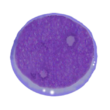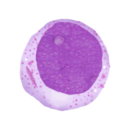The flow cytometric diagnosis of AML: Difference between revisions
From haematologyetc.co.uk
No edit summary |
No edit summary |
||
| (327 intermediate revisions by the same user not shown) | |||
| Line 1: | Line 1: | ||
---- | ---- | ||
< | <div style="width: 200px"> | ||
{| class="wikitable" style="border-left:solid 5px green;border-right:solid 5px silver;border-top:solid 5px black;border-bottom:solid 5px black; font-size:90%; color:navy" | |||
| colspan="1"''|[[Flow Cytometry|Return to previous page]]'' | |||
|} | |||
</div> | |||
-------- | |||
<div style="width: | <div style="width: 100%"> | ||
{| class="wikitable" style="border-style: solid; border-width: 5px; color:black" | {| class="wikitable" style="border-style: solid; border-width: 5px; color:black" | ||
|colspan="1" style = "font-size:90%; color:black; background:# | |colspan="1" style = "font-size:90%; color:black; background: #bcd4e6"|'''1. The immunophenotype of the blast cells should be consistent with their "primitive" nature''' | ||
|} | |} | ||
</div> | |||
[[Image:AML M1.png|110px]] | [[Image:AML M1.png|110px]] | ||
</br> | </br></br><span style="font-size:90%;">Assigning primitive nature in most cases is straightforward, but some types of AML may present difficulties.</span> | ||
<div style="width: 95%; font-size:90%;"> | |||
{| class="wikitable" style="border-style: solid; border-width: 4px; color:black" | |||
!colspan="1" style = "background:#ddeee1; border:solid; border-width: 3px;"|<span style="font-size:90%;">'''Demonstrating primitive phenotype in AML'''</span></br> | |||
|- | |||
!colspan="1" style = "background:white; border:solid; border-width: 1px; color:black"|In most cases, cells of AML will demonstrate typical features of immature cells with: '''weak expression of CD45''', and expression of '''CD34''' and/or '''CD117'''</br>However, patterns are not always typical and difficult cases other markers of early differentiation may also help</br></br>[[Markers used to demonstrate primitive nature in AML|''Click for a more detailed table of markers associated with primitive phenotype'']] | |||
|- | |||
!colspan="1" style = "background:#ddeee1;border:solid"|<span style="font-size:90%;">'''Difficulties may occur where blast cells have significant maturation so their primitive nature may be less easy to demonstrate.'''</span></br> | |||
|- | |||
!colspan="1" style = "background:white; border:solid; border-width: 1px;"|Difficulties are most frequently encountered in monocytic cases of AML, or in acute promyelocytic leukaemia (APL) (although occasionally in other types).</br></br>[[Atypical patterns of primitive marker expression in acute myeloid leukaemia|Click to see common patterns that may cause difficulty in assigning primitive phenotype]] | |||
|- | |||
|} | |||
</div> | |||
---- | ---- | ||
'''2. The | <div style="width: 100%"> | ||
{| class="wikitable" style="border-style: solid; border-width: 5px; color:black" | |||
|colspan="1" style = "font-size:90%; color:black; background:#bcd4e6"|'''2. The immunophenotype of the blast cells should allow myeloid lineage to be assigned''' | |||
|} | |||
[[Image:AML M2.png|130px]] | [[Image:AML M2.png|130px]] | ||
</br>'' | |||
<span style="font-size:90%;">The criteria to assign myeloid lineage in AML have been established, alternative sets of diagnostic criteria may be used (although many cases will meet more than one criteria set): | |||
<div style="width: 95%; font-size:90%;"> | |||
{| class="wikitable" style="border-style: solid; border-width: 4px; color:black" | |||
!colspan="1" style = "background:#ddeee1; border:solid; border-width: 3px;"|<span style="font-size:90%;">'''Pattern A: AML - diagnosis based on lineage-defining markers'''</span></br> | |||
|- | |||
!colspan="1" style = "background:white; border:solid; border-width: 1px; color:black"|A myeloid lineage-defining marker pattern is present '''and''' no lineage-defining markers of T or B cells are present</br></br> | |||
<span style="font-size:100%;">[[Flow cytometry: Myeloid-defining markers|Click to view table of criteria]]</span> | |||
|- | |||
!colspan="1" style = "background:#ddeee1;border:solid"|<span style="font-size:90%;">'''Pattern B: AML - diagnosis based on myeloid-lineage-associated marker patterns'''</span></br> | |||
|- | |||
!colspan="1" style = "background:white; border:solid; border-width: 1px;"|At least two myeloid lineage-associated markers are present '''and''' there are no lineage defining markers of T or B cells '''and''' no more than one T-cell or B-cell lineage-associated marker is present</br></br> | |||
<span style="font-size:90%;">[[Myeloid lineage-associated markers|Click to view table of criteria]]</span> | |||
|- | |||
!colspan="1" style = "background:#ddeee1;border:solid"|<span style="font-size:90%;">'''Pattern C: AML - diagnosis based on less frequent differentiation patterns'''</span></br> | |||
|- | |||
!colspan="1" style = "background:white; border:solid; border-width: 1px;"|In those rarer cases of erythroid or megakaryocytic differentiation, full myeloid criteria may not be met requiring these patterns to be specifically diagnosed.</br></br> | |||
<span style="font-size:90%;">[[Marker patterns erythroid or megakaryocyte differentiation|Click to view table of criteria]]</span> | |||
|} | |||
</div> | |||
---- | ---- | ||
<div style="width: 100%"> | |||
{| class="wikitable" style="border-style: solid; border-width: 5px; color:black" | |||
|colspan="1" style = "font-size:90%; color:black; background:#bcd4e6"|'''3. Alternative diagnoses in difficult cases''' | |||
|} | |||
[[Image:Lymphoblast.png|110px]] | |||
</div> | |||
<span style="font-size:90%;"></br>In some cases myeloid markers may be present but full lineage may be unclear - in such cases it is important to consider possible alternative diagnoses</span></br> | |||
<span style="font-size:90%;">Alternative potential diagnoses in difficult cases with myeloid marker expression:</span> | |||
<div style="width: 95%; font-size:90%;"> | |||
{| class="wikitable" style="border-style: solid; border-width: 4px; color:black" | |||
!colspan="2" style = "background:#ddeee1;border:solid"|<span style="font-size:90%;">'''Mixed Phenotype Acute Leukaemia''' (MPAL)</span> | |||
|- | |||
!colspan="2" style = "background:white;border:solid;"|Consider where myeloid lineage can be assigned based on '''lineage-specific''' patterns '''but''' the cells also have marker patterns that meet the criteria to assign T or B cell lineage.</br></br>[[Flow cytometry:MPAL|''Click for diagnostic criteria of MPAL'']] | |||
|- | |||
!colspan="2" style = "background:#ddeee1;border:solid;"|'''Acute Undifferentiated Leukaemia''' (AUL) | |||
|- | |||
!colspan="2" style = "background:white; border:solid;"|'''Consider AUL:''' In cases where the evidence is insufficient to assign myeloid lineage '''and''' there is insufficient evidence to assign to T-cell or B-cell lineage </br></br>[[Flow cytometry:AUL|''Click for diagnostic criteria of AUL'']] | |||
|- | |||
!colspan="2" style = "background:#ddeee1;border:solid"|'''Acute Leukaemia of ambiguous lineage not otherwise sepcified''' (ALAL-NOS) | |||
|- | |||
!colspan="2" style = "background:white; border:solid;"|'''Consider ALAL-NOS:''' if classification to specific lineage is not possible '''but''' blast cells cannot be classed as AUL or MPAL.</br></br>[[Flow cytometry:ALAL-NOS|''This is most often a useful provisional diagnosis - click here for details'']]</br> | |||
|- | |||
!colspan="2" style = "background:#ddeee1;border:solid"|''' Early T-cell precursor acute lymphoblastic leukaemia''' (ETP-ALL) | |||
|- | |||
!colspan="2" style = "background:white; border:solid;"| This disorder has diagnostic criteria sufficient to assign T cell lineage (cCD3 is expressed) but may express myeloid-associated antigens cases may share features with MPAL M/T</br></br>[[Flow cytometry:ETP-ALL|''Click for diagnostic criteria of ETP-ALL'']] | |||
|- | |||
!colspan="2" style = "background:#ddeee1;border:solid"|'''Blastic plasmacytoid dendritic cell neoplasm''' (BPDCN) | |||
|- | |||
!colspan="2" style = "background:white; border:solid;"|'''Consider BPDCN:''' Generally in cases that resemble AUL (rarely AML), most often with skin rash. A specific marker profile should be sought: expression of bright CD4 and/or CD56 is expected. CD33 is frequently expressed but other myeloid markers are less frequent and MPO and CD34 should be absent. Look for specific additional markers as described in the diagnostic criteria.</br></br>[[Flow cytometry:BPDCN|''Click for diagnostic criteria of BPDCN'']] | |||
|} | |||
</br></br><span style="font-size:90%;">'''FINAL NOTE''' Some "non-lineage" markers are frequently expressed in AML and may be associated with specific AML subtypes ([[Table of frequent aberrant markers in AML|Click here for further detail]]). Other features should give concern for alternative diagnosis (see the table below more detailed guidance). | |||
---- | ---- | ||
Latest revision as of 15:28, 15 March 2024
| 1. The immunophenotype of the blast cells should be consistent with their "primitive" nature |

Assigning primitive nature in most cases is straightforward, but some types of AML may present difficulties.
| Demonstrating primitive phenotype in AML |
|---|
| In most cases, cells of AML will demonstrate typical features of immature cells with: weak expression of CD45, and expression of CD34 and/or CD117 However, patterns are not always typical and difficult cases other markers of early differentiation may also help Click for a more detailed table of markers associated with primitive phenotype |
| Difficulties may occur where blast cells have significant maturation so their primitive nature may be less easy to demonstrate. |
| Difficulties are most frequently encountered in monocytic cases of AML, or in acute promyelocytic leukaemia (APL) (although occasionally in other types). Click to see common patterns that may cause difficulty in assigning primitive phenotype |
| 2. The immunophenotype of the blast cells should allow myeloid lineage to be assigned |
The criteria to assign myeloid lineage in AML have been established, alternative sets of diagnostic criteria may be used (although many cases will meet more than one criteria set):
| Pattern A: AML - diagnosis based on lineage-defining markers |
|---|
| A myeloid lineage-defining marker pattern is present and no lineage-defining markers of T or B cells are present |
| Pattern B: AML - diagnosis based on myeloid-lineage-associated marker patterns |
| At least two myeloid lineage-associated markers are present and there are no lineage defining markers of T or B cells and no more than one T-cell or B-cell lineage-associated marker is present |
| Pattern C: AML - diagnosis based on less frequent differentiation patterns |
| In those rarer cases of erythroid or megakaryocytic differentiation, full myeloid criteria may not be met requiring these patterns to be specifically diagnosed. |
In some cases myeloid markers may be present but full lineage may be unclear - in such cases it is important to consider possible alternative diagnoses
Alternative potential diagnoses in difficult cases with myeloid marker expression:
| Mixed Phenotype Acute Leukaemia (MPAL) | |
|---|---|
| Consider where myeloid lineage can be assigned based on lineage-specific patterns but the cells also have marker patterns that meet the criteria to assign T or B cell lineage. Click for diagnostic criteria of MPAL | |
| Acute Undifferentiated Leukaemia (AUL) | |
| Consider AUL: In cases where the evidence is insufficient to assign myeloid lineage and there is insufficient evidence to assign to T-cell or B-cell lineage Click for diagnostic criteria of AUL | |
| Acute Leukaemia of ambiguous lineage not otherwise sepcified (ALAL-NOS) | |
| Consider ALAL-NOS: if classification to specific lineage is not possible but blast cells cannot be classed as AUL or MPAL. This is most often a useful provisional diagnosis - click here for details | |
| Early T-cell precursor acute lymphoblastic leukaemia (ETP-ALL) | |
| This disorder has diagnostic criteria sufficient to assign T cell lineage (cCD3 is expressed) but may express myeloid-associated antigens cases may share features with MPAL M/T Click for diagnostic criteria of ETP-ALL | |
| Blastic plasmacytoid dendritic cell neoplasm (BPDCN) | |
| Consider BPDCN: Generally in cases that resemble AUL (rarely AML), most often with skin rash. A specific marker profile should be sought: expression of bright CD4 and/or CD56 is expected. CD33 is frequently expressed but other myeloid markers are less frequent and MPO and CD34 should be absent. Look for specific additional markers as described in the diagnostic criteria. Click for diagnostic criteria of BPDCN |
FINAL NOTE Some "non-lineage" markers are frequently expressed in AML and may be associated with specific AML subtypes (Click here for further detail). Other features should give concern for alternative diagnosis (see the table below more detailed guidance).

